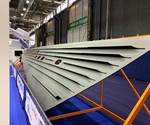Hexcel fabrics chosen for Sunseeker performance cruiser
Hexcel’s HiMax Dot Pattern Adhesive fabrics have been chosen for resin infusion of Sunseeker’s newest high-performance luxury yacht.
Hexcel’s (Stamford, Conn., U.S.) HiMax Dot Pattern Adhesive (DPA) technology has been selected by luxury motor yacht manufacturer Sunseeker (Poole, U.K.) for the resin infusion of Sunseeker’s new performance cruiser. The Predator 50 is the first of the Sunseeker yachts to be built with Hexcel’s DPA composite technology.
Hexcel has developed the HiMax DPA technology to add further value to its range of multiaxial reinforcements. The DPA reinforcements come pre-tacked for ease of laying up multiple fabrics in preparation for infusion. Designed to provide the optimal level of tack while minimizing additional weight, they reportedly eliminate the need for a spray adhesive, which reduces the risk of inconsistent application, contamination and excess weight. The DPA fabrics have a controlled level of adhesive applied by machine in dots across the whole fabric, weighing 3 grams per square meter.
Sunseeker, a long-standing customer of Hexcel, has implemented a range of HiMax fabrics in the Predator 50, including quadaxials and 0/45 biaxials, with the dot pattern adhesive on one or both sides of the fabric. The company says benefits of using the fabrics have included reduced layup time, ease of handling the fabrics without a spray adhesive and constant fabric quality.
“Our focus is always on the customer,” says Chris Wright, Predator 50 project manager at Sunseeker. “We are continually looking at what the customer wants from his or her boat, and meeting or exceeding expectations. Quality is important to us, but so is repeatability and manufacturing efficiency so we can offer excellent value. With HiMax DPA materials, we know we are achieving a consistently high standard of build, and we are providing a cleaner and safer working environment for our staff.”
“The HiMax DPA products can be used in a wide variety of marine applications,” says Garth Thomas, Hexcel sales engineer for the marine sector. “The non-crimp construction of the range, the option to integrate different infusion cores and the availability of multi-stack fabrics help reduce the time to market. Our novel composites technology has proven to be successful; over 50% of Hexcel’s marine fabrics are now supplied with DPA reinforcements.”
Related Content
-
Materials & Processes: Composites fibers and resins
Compared to legacy materials like steel, aluminum, iron and titanium, composites are still coming of age, and only just now are being better understood by design and manufacturing engineers. However, composites’ physical properties — combined with unbeatable light weight — make them undeniably attractive.
-
Materials & Processes: Fibers for composites
The structural properties of composite materials are derived primarily from the fiber reinforcement. Fiber types, their manufacture, their uses and the end-market applications in which they find most use are described.
-
Price, performance, protection: EV battery enclosures, Part 1
Composite technologies are growing in use as suppliers continue efforts to meet more demanding requirements for EV battery enclosures.

.jpg;width=70;height=70;mode=crop)














